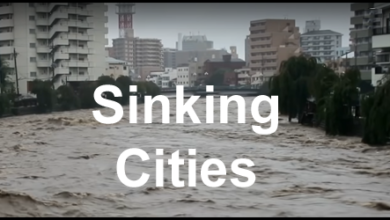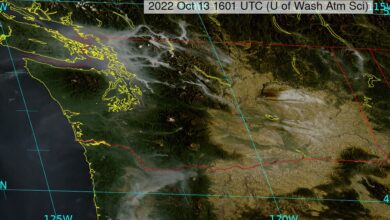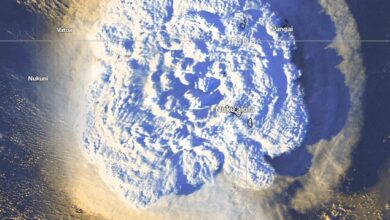Glacial Armageddon! 2/3 to vanish by 2100!

Guest “Lions and Tigers and Bears!” by David Middleton
Study: Two-thirds of glaciers on track to disappear by 2100
By SETH BORENSTEIN
January 5, 2023The world’s glaciers are shrinking and disappearing faster than scientists thought, with two-thirds of them projected to melt out of existence by the end of the century at current climate change trends, according to a new study.
[…]
The study in Thursday’s journal Science examined all of the globe’s 215,000 land-based glaciers — not counting those on ice sheets in Greenland and Antarctica — in a more comprehensive way than past studies. Scientists then used computer simulations to calculate, using different levels of warming, how many glaciers would disappear, how many trillions of tons of ice would melt, and how much it would contribute to sea level rise.
[…]
Yes… I know… I should have stopped reading after “Seth Borenstein”… That said, I took the time to dig up the “new study” (Rounce et al., 2023) and found that the paper wasn’t awful… However…
And it appears to be more advocacy than science. The paper is linked to this “perspective” article:
Acting now will reduce glacier loss
Many of the world’s glaciers will disappear, but quick action will make a differenceAbstract
As global mean temperature rises in pace with increasing greenhouse gas emissions, the future of the world’s glaciers looks bleak. Rates of glacier mass loss have increased over the past two decades (1), a trend that will continue even if emissions are capped (2–4). Despite their small size relative to the Greenland and Antarctic ice sheets, these dwindling ice stores are important. They currently contribute as much to sea level as the ice sheets (3), their disappearance means water insecurity for millions, and their retreat increases glacier hazard frequency, such as glacier outburst floods and landslides (2). Although most countries have agreed to pursue temperature limits within 1.5°C above preindustrial levels (5), these targets are unmet (6). On page 78 of this issue, Rounce et al. (7) present a model of the fate of all 215,547 glaciers under different climate scenarios. Their findings emphasize the need to act now to prevent substantial glacier loss.
If I was cynical, I would say that Rounce et al was written for the sole purpose of science-ing up another pathetic plea to ban the use of fossil fuels.
According to the study, the world currently has 215,547 alpine/valley glaciers. While I seriously doubt that detailed mass balance studies have been carried out on all 215,547, the number sounds reasonable. The 2/3’s of glaciers (144,416 or ~44% of total ice mass) hypothetically destined to vanish will do so under the nearly physically impossible RCP8.5 scenario. Even if we undiscovered fire tomorrow (RCP2.6), half of the glaciers (107,774) would still be toast by the turn of the century. Returning to the Stone Age in order to save 36,443 smallish glaciers doesn’t sound like a good deal to me… But I make my living finding oil and gas… And I’m a geologist… So, I’m doubly biased. Be that as it may… Scale and context seem to be missing from the assertion that “two-thirds of glaciers on track to disappear by 2100.” Even if they “disappear,” will this be significant relative to what glaciers were already doing in the Quaternary Period?
The subject paper forecasts what might happen to glaciers over the period from 2015 to 2100. Presumably, every thing that has happened or will happen to all things climate since 1950 were or will be due to fossil fuel consumption and the resultant emissions of so-called greenhouse gases. While the evidence of an anthropogenic climate change fingerprint since 1950 is equivocal, at best, predictions about the distant future are about as useful as mammary glands on a bull. When I make a prediction at work, it’s generally tested by drilling a well within a year or two of the prediction. If I make a prediction about the results of a well, that won’t reach the objective until 2100, I won’t be around to see if my prediction was at least in the ballpark.
However, we can provide some scale and context to the glacier issue by looking at what they were doing before the alleged anthropogenic fingerprint allegedly emerged from the climatic noise level.
Most of the remainder of this post was sourced from WUWT posts I previously authored.
The cool thing about “new” CAGW studies, is that they’ve usually already been debunked on WUWT. What does it mean to “debunk” something?
debunk
to show that something is less important, less good, or less true than it has been made to appear
Debunking doesn’t require that something be demonstrated to be false. It only requires demonstrating that it is less, usually far less, important (or significant) than asserted.
What were glaciers doing before SUV’s?
Glacier mass balance is a way to measure changes in the cryosphere. A glacier with a negative mass balance is losing more ice than it gains annually. A glacier with a positive mas balance is gaining more ice than it loses annually.
Total global glacier mass balance has been negative since the end of Neoglaciation in the mid-1800’s. When glaciers and ice sheets have negative mass balances, some of the meltwater eventually finds its way to the ocean and sea level rises. Over most of the past 150 years, more glaciers have been retreating (negative mass balance) than advancing (positive mass balance).
Another way to measure glacial advance and retreat is by changes in glacier length. Oerlemans’ 2005 climate reconstruction was derived from changes in global stacked glacier length. The following graph overlays atmospheric CO2 and northern hemisphere temperatures on Oerlemans’ stacked glacier length plot. The glacial length is relative to 1950.

In the extremely unlikely event that the climate models are right, 90% of the ice loss occurred before an anthropogenic fingerprint could be discerned.



What were the glaciers doing before the Model T?



Could it possibly be true that most the the magnificent glaciers, about which Seth Borenstein waxed so eloquently, had already largely disappeared before the word “climatologist” had even been coined?



Glaciers are always advancing or retreating… The may move at a glacial pace, but they do move. People living in a world with advancing glaciers are not likely to thrive as well as they would in a world of retreating glaciers.
I wonder if Mr. Borenstein is aware of the fact that the “temperature rise since pre-industrial times” began at a time when Earth was colder and more ice-covered than at any point since the end of the Pleistocene Epoch.
Little Ice Age
JUNE 5, 2015 / K. JAN OOSTHOEK[…]
During the height of the Little Ice Age , it was in general about one degree Celsius colder than at present. The Baltic Sea froze over, as did most of the rivers in Europe. Winters were bitterly cold and prolonged, reducing the growing season by several weeks. These conditions led to widespread crop failure, famine, and in some regions population decline.
The prices of grain increased and wine became difficult to produce in many areas and commercial vineyards vanished in England. Fishing in northern Europe was also badly affected as cod migrated south to find warmer water. Storminess and flooding increased and in mountainous regions the treeline and snowline dropped. In addition glaciers advanced in the Alps and Northern Europe, overrunning towns and farms in the process.
Iceland was one of the hardest hit areas. Sea ice, which today is far to the north, came down around Iceland. In some years, it was difficult to bring a ship ashore anywhere along the coast. Grain became impossible to grow and even hay crops failed. Volcanic eruptions made life even harder. Iceland lost half of its population during the Little Ice Age.
Tax records in Scandinavia show many farms were destroyed by advancing ice of glaciers and by melt water streams. Travellers in Scotland reported permanent snow cover over the Cairngorm Mountains in Scotland at an altitude of about 1200 metres. In the Alps, the glaciers advanced and threatened to bulldozed towns. Ice-dammed lakes burst periodically, destroying hundreds of buildings and killing many people. As late as 1930 the French Government commissioned a report to investigate the threat of the glaciers. They could not have foreseen that human induced global warming was to deal more effective with this problem than any committee ever could.
“Many farms were destroyed by advancing ice of glaciers and by melt water streams”… “Ice-dammed lakes burst periodically, destroying hundreds of buildings and killing many people”… Sounds like an actual climate crisis to me.
History of Glaciers in Glacier National Park
The history of glaciation within current Glacier National Park boundaries spans centuries of glacial growth and recession, carving the features we see today. Glaciers were present within current Glacier National Park boundaries as early as 7,000 years ago but may have survived an early Holocene warm period (Carrara, 1989), making them much older. These modest glaciers varied in size, tracking climatic changes, but did not grow to their Holocene maximum size until the end of the Little Ice Age (LIA) around A.D. 1850. While they may not have formed in their entirety during the LIA, their maximum perimeters can be documented through mapping of lateral and terminal moraines. (Key, 2002) The extent and mass of these glaciers, as well as glaciers around the globe, has clearly decreased during the 20th century in response to warmer temperatures.Climate reconstructions representative of the Glacier National Park region extend back multiple centuries and show numerous long-duration drought and wet periods that influenced the mass balance of glaciers (Pederson et al. 2004). Of particular note was an 80-year period (~1770-1840) of cool, wet summers and above-average winter snowfall that led to a rapid growth of glaciers just prior to the end of the LIA. Thus, in the context of the entire Holocene, the size of glaciers at the end of the LIA was an anomaly of sorts. In fact, the large extent of ice coverage removed most of the evidence of earlier glacier positions by overriding terminal and lateral moraines.
Tree-ring based climate records and historic photographs indicate the initiation of frontal recession and ice mass thinning between A.D. 1860 and 1880. The alignment of decadal-scale climate anomalies over the early 20th century produced a period of glacial recession somewhat analogous to conditions experienced over the past few decades. The coupling of hot, dry summers with substantial decreases in winter snowpack (~30% of normal) produced dramatic recession rates as high as 100 m/yr from A.D. 1917-1941 (Pederson et al. 2004). These multidecadal episodes have substantially impacted the mass balance of glaciers since A.D. 1900.
The glaciers of Glacier National Park reached their maximum Holocene extent about 150 years ago and may not have existed at all prior to 7,000 years ago.
Most alpine and valley glaciers formed after the Holocene Climatic Optimum and generally advanced until the early to mid 1800’s. This period is known as Neoglaciation. Since the end of Neoglaciation most alpine and valley glaciers have been retreating. Neoglaciation ended long-before CO2 levels had risen much above 280 ppm.
While vanishing glaciers sound awful, advancing glaciers are a lot worse.
References
Bohleber, P., Schwikowski, M., Stocker-Waldhuber, M. et al. New glacier evidence for ice-free summits during the life of the Tyrolean Iceman. Sci Rep 10, 20513 (2020). https://doi.org/10.1038/s41598-020-77518-9
Dyke, A.S., Moore, A. and L. Robertson. [computer file]. Deglaciation of North America. Geological Survey of Canada Open File 1547. Ottawa: Natural Resources Canada, 2003.
Grosjean, Martin, Suter, Peter, Trachsel, Mathias & Wanner, Heinz. (2007). “Ice‐borne prehistoric finds in the Swiss Alps reflect Holocene glacier fluctuations”. Journal of Quaternary Science. 22. 203 – 207. 10.1002/jqs.1111.
Kaufman, D., McKay, N., Routson, C. et al. Holocene global mean surface temperature, a multi-method reconstruction approach. Sci Data 7, 201 (2020). https://doi.org/10.1038/s41597-020-0530-7
MacFarling-Meure, C., D. Etheridge, C. Trudinger, P. Steele, R. Langenfelds, T. van Ommen, A. Smith, and J. Elkins (2006). “Law Dome CO2, CH4 and N2O ice core records extended to 2000 years BP“. Geophys. Res. Lett., 33, L14810, doi:10.1029/2006GL026152.
Moberg, A., D.M. Sonechkin, K. Holmgren, N.M. Datsenko and W. Karlén. 2005. “Highly variable Northern Hemisphere temperatures reconstructed from low- and high-resolution proxy data”. Nature, Vol. 433, No. 7026, pp. 613-617, 10 February 2005.
Oerlemans, J. “Extracting a climate signal from 169 glacier records”. Science (80-. ). 2005, 308, 675–677, doi:10.1126/science.1107046.
Rounce, David R., Regine Hock, Fabien Maussion, Romain Hugonnet, William Kochtitzky, Matthias Huss, Etienne Berthier et al. “Global glacier change in the 21st century: Every increase in temperature matters.” Science 379, no. 6627 (2023): 78-83.




